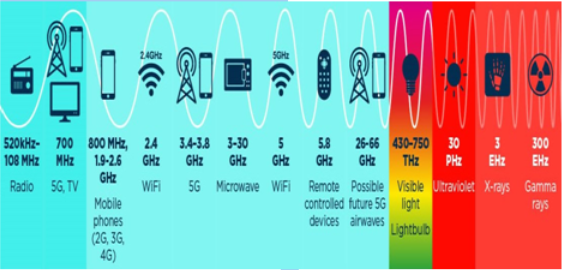WAVELENGTH – Understanding Network and Security for Far-Edge Computing
Wavelength is the physical length of an entire wave cycle. It is usually represented by the Greek letter lambda (�). It is measured in terms of length such as meters, centimeters, millimeters, nanometers, and so on.
You can figure out the wavelength if you know the frequency and vice versa because of the following relationships:


λ represents the wavelength, n the frequency, and c the speed of light
There are many calculators on the internet to help you make the conversion, but it is important to understand that these two things are tightly related.
Because c is so fast, 1Hz is a really low frequency and conversely would be a very long wavelength – about 186,282 miles (300,000 km). The only communication systems that get anywhere close to that (~50Hz) have to use the Earth itself as an antenna to generate long enough radio waves. They are called Extremely Low Frequency (ELF) and are used to communicate with submarines deep underwater – at data rates measured in a few bits per second. On the other hand, a 24GHz 5G signal that your mobile device receives only has a wavelength of 12.5mm – with achievable data rates of multiple gigabits/sec.
To recap, remember these general rules about frequencies:
Lower frequencies: They have longer wavelengths, are effective over longer distances2, and penetrate obstructions better3, but have lower data rates
2 A more accurate way to explain this is to say shorter wavelengths travel less far before attenuation, or loss of field strength, makes them unusable.
3 Different kinds of materials affect electromagnetic signals differently. Not all obstructions are the same.
Higher frequencies: They have shorter wavelengths, travel shorter distances2, and are more affected by obstructions3, but have higher data rates
EM spectrum
Different communication technologies use different parts (also called bands) within the electromagnetic spectrum. Take a look at the following figure. You will notice that there is no fundamental difference between AM radio, Wi-Fi, visible light, X-rays, and even deadly gamma rays. The difference is simply one of frequency:

Figure 3.2 – Overview of how the electromagnetic spectrum is used
There’s no need to worry, though. Your Wi-Fi signal operates at a frequency of 5 GHz, while visible blue light has a frequency of 750THz – over 150,000 times higher. Gamma rays are 200 million times higher. X-rays have wavelengths the size of an atom and gamma rays are the size of an atomic nucleus. It’s a completely different ballpark. RF technologies are often referred to with an abbreviation, such as VHF or UHF. Those acronyms refer to the ITU frequency band specification they operate within.
You may also like
Archives
- August 2024
- July 2024
- June 2024
- May 2024
- April 2024
- March 2024
- February 2024
- January 2024
- December 2023
- November 2023
- October 2023
- September 2023
- August 2023
- July 2023
- May 2023
- April 2023
- February 2023
- January 2023
- November 2022
- October 2022
- September 2022
- August 2022
- July 2022
- June 2022
- May 2022
- April 2022
- December 2021
- November 2021
- October 2021
- September 2021
- June 2021
Calendar
| M | T | W | T | F | S | S |
|---|---|---|---|---|---|---|
| 1 | 2 | 3 | 4 | 5 | 6 | |
| 7 | 8 | 9 | 10 | 11 | 12 | 13 |
| 14 | 15 | 16 | 17 | 18 | 19 | 20 |
| 21 | 22 | 23 | 24 | 25 | 26 | 27 |
| 28 | 29 | 30 | 31 | |||
Leave a Reply